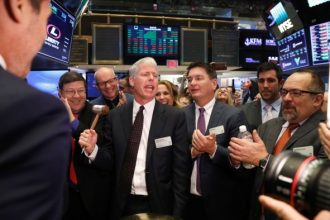There isn’t much more to wish for from the market this year after the Federal Reserve delivered the prospect of monetary easing wrapped in a big, shiny bow.
The Fed’s so-called dot plot forecasts three interest-rate cuts in 2024, and the market expects even more. Either way, the hint of looser monetary policy was enough to send markets on a tear. The
Dow Jones Industrial Average
surged 2.9% this past week—reaching a record high—while the
S&P 500 index
climbed 2.5%, and the
Nasdaq Composite
advanced 2.85%. The yield on the 10-year Treasury note closed below 4% for the first time since July 31.
Even better, the rally has broadened out beyond the Magnificent Seven. That cohort of tech-related stocks, which includes
Apple
and
Nvidia,
are collectively up nearly 75% for the year, and have largely driven the S&P 500’s 22% gain. But this past week, lagging sectors like materials and real estate—which both climbed more than 4.5%—caught a bid.
For the remaining two weeks of 2023, the recent rally leaves investors with little to do—even less-than-dovish comments from New York Fed President John Williams on Friday failed to slow the market’s momentum. Barring any shocks, the good tidings are likely to linger through year end.
“Markets interpreted the [Federal Open Market Committee] meeting as a green light to price in the perfect investment backdrop for 2024: falling inflation and moderate economic growth,” says David Donabedian, chief investment officer at CIBC Private Wealth US. “This is a powerful rally, and not one to get in the way of in a seasonally positive time for equities.”
As if to confirm the rally, a bull, later named Ricardo, was seen running on the train tracks in Newark, N.J., perhaps trying to make his way to Wall Street while also avoiding the slaughterhouse. That coincidence is as auspicious a sign to rest easy for the next few weeks and enjoy the holiday season as we’re likely to get.
Avoiding the slaughterhouse will be key in 2024. It’s true that lower interest rates help consumers and businesses alike. Mortgage rates, for instance, fell below 7% this past week for the first time since August, which could get potential home buyers off the sidelines. Businesses, too, will enjoy lower borrowing costs, greasing the wheels for more deal making and hiring. But it’s also important to consider the reasons why rates could be heading lower.
“The Fed doesn’t cut interest rates to be magnanimous; they cut interest rates because they see weakness in the economy or rising financial risks,” Donabedian says. He expects that to play out next year as the proverbial “long and variable lags” of monetary tightening are felt in the economy.
That could lead to a credit-tightening recession, something that seems likely, given that traders are pricing in as many as six rate cuts in the next year, a sign that any economic landing will be “more hard than soft,” Donabedian says. A slowdown could last for a few quarters but create a setup for a more durable bull market in the back half of 2024.
If he is right, investors will want to sober up a bit with their asset allocations. Small-cap and mid-cap stocks tend to outperform when rates tick down, but with the
Russell 2000
up 16.4% in the past five weeks, it may not be time to pull the trigger, even though the valuations are compelling. Instead, investors might want to consider the safer parts of the market that had fallen out of favor and are only starting to recover: utilities, consumer staples, and healthcare.
Remember, too much holiday cheer can lead directly to the post-party blues.
Write to Carleton English at [email protected]
Read the full article here





